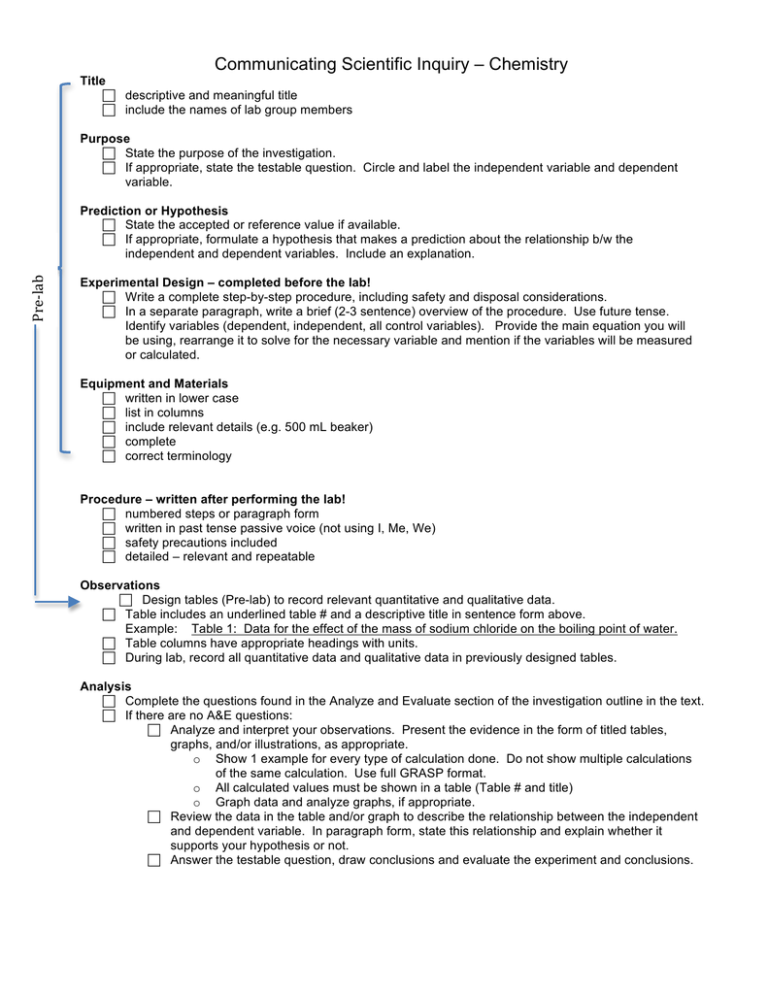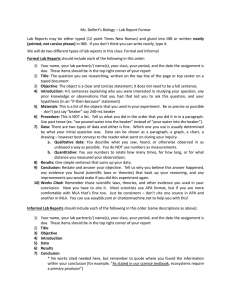Communicating Scientific Inquiry – Chemistry
advertisement

Communicating Scientific Inquiry – Chemistry Title descriptive and meaningful title include the names of lab group members Purpose State the purpose of the investigation. If appropriate, state the testable question. Circle and label the independent variable and dependent variable. Pre-­‐lab Prediction or Hypothesis State the accepted or reference value if available. If appropriate, formulate a hypothesis that makes a prediction about the relationship b/w the independent and dependent variables. Include an explanation. Experimental Design – completed before the lab! Write a complete step-by-step procedure, including safety and disposal considerations. In a separate paragraph, write a brief (2-3 sentence) overview of the procedure. Use future tense. Identify variables (dependent, independent, all control variables). Provide the main equation you will be using, rearrange it to solve for the necessary variable and mention if the variables will be measured or calculated. Equipment and Materials written in lower case list in columns include relevant details (e.g. 500 mL beaker) complete correct terminology Procedure – written after performing the lab! numbered steps or paragraph form written in past tense passive voice (not using I, Me, We) safety precautions included detailed – relevant and repeatable Observations Design tables (Pre-lab) to record relevant quantitative and qualitative data. Table includes an underlined table # and a descriptive title in sentence form above. Example: Table 1: Data for the effect of the mass of sodium chloride on the boiling point of water. Table columns have appropriate headings with units. During lab, record all quantitative data and qualitative data in previously designed tables. Analysis Complete the questions found in the Analyze and Evaluate section of the investigation outline in the text. If there are no A&E questions: Analyze and interpret your observations. Present the evidence in the form of titled tables, graphs, and/or illustrations, as appropriate. o Show 1 example for every type of calculation done. Do not show multiple calculations of the same calculation. Use full GRASP format. o All calculated values must be shown in a table (Table # and title) o Graph data and analyze graphs, if appropriate. Review the data in the table and/or graph to describe the relationship between the independent and dependent variable. In paragraph form, state this relationship and explain whether it supports your hypothesis or not. Answer the testable question, draw conclusions and evaluate the experiment and conclusions. Error Analysis Consider the experimental design, the procedure and your lab skills. Were they all adequate? Are there any control variables that you did not account for that might have affected your dependent variable? These are your errors. (i.e.: revisit your fishbone diagram). List 3 errors. For each error stated above, discuss the effect of this error on a particular observation how it affected your results (i.e. higher or lower than expected) procedural modifications that would lead to more reliable or accurate results Application and Extensions Answer the Apply and Extend questions in the text. If no questions are provided, connect the relationship discovered between the variables to some aspect of real life. Determining the Density of Water Purpose To determine the density of water by experiment. Prediction The accepted value for the density of water is 1.00 g/mL. Experimental Design Procedure (pre-lab) 1. Measure and record the mass of an empty beaker using the electronic balance. 2. Transfer 5.00 mL of water to the beaker using a pipette. 3. Record the volume of water used. 4. Measure and record the mass of the water and beaker. Repeat steps 2-4 for 10.00 mL and 20.00 mL of water. 5. Dispose of the water in the sink. 6. There are no hazardous materials used in this investigation. The mass of a measured volume of water will be measured and recorded. The density of water will be calculated using the following formula: D=m V where D is the density of the water in g/mL, m is the mass of the water in g, and V is the volume of the water in mL. Equipment and Materials 150 mL beaker 25 mL pipette electronic balance water Procedure (written after the lab) The mass of an empty beaker was measured and recorded. 5.00 mL of water was transferred to the beaker using the pipette. The volume of water was recorded. The beaker with water was placed on the balance. The mass was measured and recorded. The water was poured in the sink. The procedure was repeated for 10.0 mL and 20.00 mL of water. No hazardous materials were used in the experiment. Observations Table 1: Data for the determination of the density of water Trial volume of H2O(l) mass of H2O (mL) (mL) 1 5.00 5.10 2 10.00 10.05 3 20.00 20.21 *Entries in italics were recorded during the experiment. (i.e. not part of the pre-lab) Analysis Sample Calculation using Trial 1 m = 5.02 g V = 5.00 mL D=? D=m V = 5.10 5.00 = 1.02 g/mL Table 2: Results for density of water Trial density (g/mL) 1 1.02 2 1.01 3 1.01 average density 1.01 Average density of water = 1.02 + 1.01 + 1.01 3 = 1.01 g/mL % difference = I accepted value – experimental value I accepted value = I 1.00 – 1.01 I 1.00 x x 100 100 = 1.00 % The density of water as determined by experiment is 1.01 g/mL. Considering 1.00 % difference, there is a high degree of confidence in the result. Error Analysis The beaker was not dried between trials. As a result, water remaining in the beaker would have increased the mass of the measured volume of water. Consequently, the measured mass of water would have been higher than expected, increasing the value of the calculated density. Dry the beaker between trials to eliminate this error. Communicating Scientific Inquiry Checklist – Pre-lab Components Title descriptive and meaningful lab group members Purpose stated with clarity proper testable question o independent variable o dependent variable. Prediction or Hypothesis accepted or reference value if available prediction with explanation Experimental Design – completed before the lab! complete step-by-step procedure, relevant and repeatable, including safety and disposal considerations brief overview variables (dependent, independent, all control variables) equation provided, required variable is isolated, measured or calculated variables are indicated Equipment and Materials written in lower case list in columns include relevant details (e.g. 500 mL beaker) complete correct terminology Observations Observations tables are designed for quantitative and qualitative data. # and title appropriate column headings with units fully lined with a ruler Communicating Scientific Inquiry Checklist – Post-lab Procedure – written after performing the lab! numbered steps or paragraph form written in past tense passive voice (not using I, Me, We) safety precautions included detailed – relevant and repeatable Observations tables (title, #, fully lined, units) quantitative data: o complete and relevant o measurements include correct significant digits qualitative data: o detailed and complete o proper scientific terminology o presented in organized manner Analysis Complete the questions found in the Analyze and Evaluate section of the investigation outline in the text. If there are no A&E questions: Calculations: o sample calculation is shown o full GRASP format o correct significant digits o correct units o all results are summarized in a table (#, title, fully lined with ruler) Graphs: o large size (1/2 to 1 page) o pencil o Title o axis are labeled, including units o dot points o line of best fit (linear or smooth curve) o origin is included or excluded as appropriate Analysis: o results are summarized in sentence form o relationship between the independent and dependent variable is described o comparison of results to hypothesis is described o relevant theory is used to explain observations and results • limited • fair • reasonable and detailed • thorough and insightful Evaluation: o % difference is calculated o confidence in results is discussed Error Analysis errors are stated the effect of each error on a particular observation is explained how the calculated result is affected is explained procedural modifications are provided Application and Extensions Answer the Apply and Extend questions in the text. the relationship discovered between the variables is connected to some aspect of real life o limited o fair o reasonable and detailed o thoughtful and insightful





